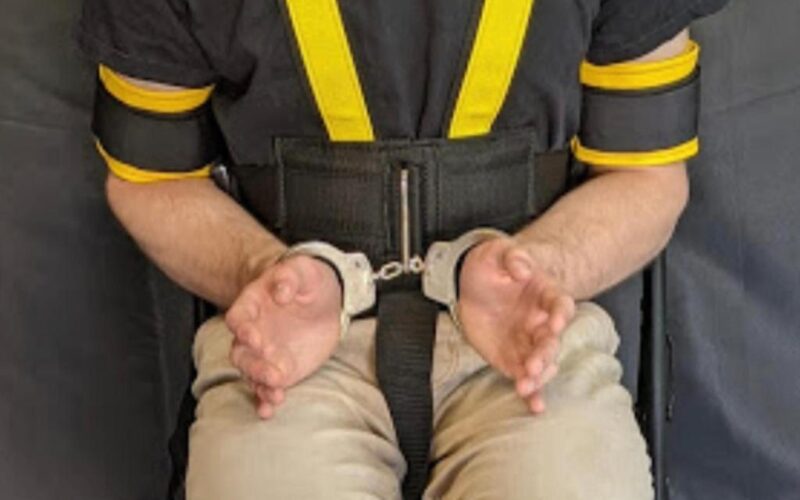By JASON DEAREN, JIM MUSTIAN and DORANY PINEDA, Associated Press
The Nigerian man described being roused with other detainees in September in the middle of the night. U.S. Immigration and Customs Enforcement officers clasped shackles on their hands and feet, he said, and told them they were being sent to Ghana, even though none of them was from there.
When they asked to speak to their attorney, he said, the officers refused and straitjacketed the already-shackled men in full-body restraint suits called the WRAP, then loaded them onto a plane for the 16-hour-flight to West Africa.
Referred to as “the burrito” or “the bag,” the WRAP has become a harrowing part of deportations for some immigrants.
“It was just like a kidnapping,” the Nigerian man, who’s part of a federal lawsuit, told The Associated Press in an interview from the detainment camp in which he and other deportees were being held in Ghana. Like others placed in the restraints interviewed by the AP, he spoke on the condition of anonymity for fear of reprisals.
The AP identified multiple examples of ICE using the black-and-yellow full-body restraint device, the WRAP, in deportations. Its use was described to the AP by five people who said they were restrained in the device, sometimes for hours, on ICE deportation flights dating to 2020. And witnesses and family members in four countries told the AP about its use on at least seven other people this year.
The AP found ICE has used the device despite internal concerns voiced in a 2023 report by the civil rights division of its parent agency, the U.S. Department of Homeland Security, in part due to reports of deaths involving use of the WRAP by local law enforcement. And the AP has identified a dozen fatal cases in the last decade where local police or jailers around the U.S. used the WRAP and autopsies determined “restraint” played a role in the death.
The WRAP is the subject of a growing number of federal lawsuits likening incorrect usage of the device to punishment and even torture, whether used in a jail or by immigration authorities during international flights. Among advocates’ concerns is that ICE is not tracking the WRAP’s use as required by federal law when officers use force.

DHS has paid Safe Restraints Inc., the WRAP’s California-based maker, $268,523 since it started purchasing the devices in late 2015 during the Obama administration. Government purchasing records show the two Trump administrations have been responsible for about 91% of that spending. ICE would not provide AP with records documenting its use of the WRAP despite multiple requests, and it’s not clear how frequently it has been used in the current and prior administrations.
The WRAP’s manufacturer says it intended the device to be a lifesaver for law enforcement confronting erratic people who were physically attacking officers or harming themselves.
But ICE officials have a much lower threshold for deploying the WRAP than the manufacturer advises, the AP found. Detainees interviewed by the AP said ICE officers used the restraints on them after they had been shackled. They said this was done to intimidate or punish them for asking to speak to their attorneys or expressing fear at being deported, often to places they fled due to violence and torture.
The West African deportee described a terrifying, hourslong experience that left his legs swollen to the point where he walked with a limp.
“They bundled me and my colleagues,” he said, “tied us up in a straitjacket.”
ICE and DHS would not answer detailed questions from the AP and refused a request for the government’s policy for when and how to use the WRAP.
“The use of restraints on detainees during deportation flights has been long standing, standard ICE protocol and an essential measure to ensure the safety and well-being of both detainees and the officers/agents accompanying them,” Tricia McLaughlin, DHS’ spokesperson, said in an email to AP. “Our practices align with those followed by other relevant authorities and is fully in line with established legal standards.”
The agency would not specify those authorities or describe its practices.
“The use of these devices is inhumane and incompatible with our nation’s fundamental values,” said Noah Baron, an attorney for the West African deportees.
Charles Hammond, CEO of Safe Restraints Inc., said his company has made a modified version of the device for ICE, with changes meant to allow people to be kept in it during flights and long bus trips.
ICE’s version includes a ring on the front of the suit that allows a subject’s cuffed hands to be attached while still allowing for limited use to eat and drink, he said. In addition, the ICE version has “soft elbow cuffs,” Hammond said, which connect in the back so a person can move for proper circulation but can’t flip an elbow out to hit someone.
An AP reporter recounted for Hammond some of the allegations made by people who had been placed in the WRAP for long flights. All of those interviewed by AP said their hands and feet were already restrained by chains. All denied fighting with officers, saying they were either crying or pleading against their deportation to countries they deemed dangerous.
Hammond said that, if true that some people were not being violent and simply protesting verbally, putting them in the WRAP could be improper use.
“That’s not the purpose of the WRAP. If (the deportee) is a current or potential risk to themselves, to officers, to staff, to the plane, restraints are justified. If it’s not, then restraints aren’t.”
‘Please help me’
Juan Antonio Pineda said he was put into “a bag” in late September and driven by immigration officers to the Mexico border. It was black with yellow stripes and had straps that immobilized his body and connected over his shoulders — the WRAP.

Pineda, who is from El Salvador, was in the U.S. legally, he said in a video from an ICE detention center in Arizona. On Sept. 3, he went to an appointment in Maryland to get permission for another year, his wife, Xiomara Ochoa, said in an interview from El Salvador. Instead, he was detained by ICE and told he’d be deported to Mexico, but the documents he was shown had someone else’s name, he said. Even so, he was sent to the Florence Service Processing Center detention facility in Arizona.
Early morning on Wednesday, Sept. 24, he said officers tied his hands and legs, placed him into the “bag” and drove him four hours to the border. When he refused to sign the deportation papers, Pineda alleges officers broke his right arm and gave him a black eye before driving him back another four hours in the “bag.” The AP was unable to independently confirm how he was injured. Pineda’s video shows him with a cast on his arm and bruising on his face.
The next day, Thursday, Sept. 25, they tied him up again, put him in the bag and drove him to the border, where Mexican immigration officials turned him away, he said.
“Eight hours there and back and they don’t give me food or water or anything,” he said in the video, which his wife shared with the AP. “Please help me.”
He was ultimately deported to Mexico, Ochoa said.
ICE did not respond to multiple requests for comment from the AP regarding Pineda’s case.
In addition to the Nigerian man flown to Ghana, four others interviewed by AP said they were placed in the WRAP and carried onto deportation flights since the first Trump administration.
As U.S. immigration officials move aggressively to meet the president’s deportation goals, advocates and attorneys for immigrants are echoing the concerns of the government’s own civil rights inquiry that ICE officers aren’t trained on how to use the restraints.
“This should be a last resort type of restraint after they’ve already tried other things,” said Fatma Marouf, a Texas A&M law professor who has sued ICE over its use of the device. “Just being bound up like that can inflict a lot of psychological harm.”
Some deportees said they were left in the WRAP for an entire fight. A lawsuit filed on behalf of the Nigerian man and four others currently detained in Dema Camp, Ghana, included the allegation from one that ICE left the restraint suit on him for 16 hours, only once undoing the lower part so he could use the bathroom.
“No one should be put into a WRAP. I don’t even think they strap animals like that,” recalled a man who said he suffered a concussion and dislocated jaw being placed into the device in 2023 before a deportation flight to Cape Verde, an African island nation. AP’s review of his medical records confirmed he suffered those injuries in 2023.
“It was the most painful thing I’ve been through,” said the man, adding he was restrained most of the 10-hour flight. “Forget the assault, forget the broken jaw. Just the WRAP itself was hurtful.”
Also, the man said, the metal ring his cuffed hands were attached to — one of the ICE modifications to the WRAP designed to increase comfort — injured him. “When they slammed me face forward on the floor, that metal ring dug into my chest causing me bruising and pain which was part of my injuries that I complained about.”
ICE’s current use of the WRAP comes amid an unprecedented wave of masked federal immigration officers grabbing suspected immigrants off the street, and mounting accusations that the Trump administration has dehumanized them, including by subjecting them to cruel and unusual detention conditions.
ICE’s use of the WRAP has continued despite a 2023 report by DHS’s Office for Civil Rights and Civil Liberties, or CRCL, that raised serious concerns over the lack of policies governing its use.
ICE agreed with the internal findings on some points, a then-DHS official involved in the review said, but challenged the notion that the WRAP should be classified as a “four-point restraint,” a designation that would place more limitations on its use. The person spoke on condition of anonymity because they weren’t authorized to discuss the inquiry.
DHS largely dismantled the office that produced the 2023 report earlier this year amid widespread government firings, calling it a roadblock to enforcement operations.
“Without changes to the current training, and the lack of policy, CRCL has serious concerns about ICE’s continued use of the WRAP,” wrote the report’s authors, who cited a news article mentioning lawsuits claiming the device had led to deaths.
Use by police and in jails
Last year police officers in Virginia Beach, Virginia, placed Rolin Hill in the WRAP, saying he was being combative during an arrest at a convenience store. The officers left Hill in the device when they dropped him at the jail. Video from the jail shows deputies punching the WRAP-immobilized Hill in the head and back. Hill died in a hospital, and while the WRAP’s exact role is unknown, Hill’s death was ruled a homicide by “positional and mechanical asphyxia due to restraint with neck and torso compression.” Three of the deputies are now charged with his murder, and five were removed from their jobs.
Also last year, in Missouri, prosecutors charged five jailers in the death of Othel Moore Jr., who according to an autopsy asphyxiated in the WRAP. Jailhouse footage showed Moore, who’d also been sprayed with tear gas and placed in a “spit mask” covering his face, repeatedly told officers he couldn’t breathe.
AP identified many of the other non-ICE cases involving the WRAP during an investigation into deaths after police subdued people with common tactics that, unlike guns, are meant to stop someone without killing them.
While Hammond insists the WRAP has never been determined as the cause of death when used properly, the AP identified 43 times in which the WRAP was used by police or correctional officers in a case in which someone died. In 12 of those cases the official autopsy determined that “restraint” played some role in the death.
It was often impossible to determine the exact role the WRAP may have played, as deaths often involved the use of other potentially dangerous force on people who in several cases were high on methamphetamine.
The WRAP first appeared in law enforcement in the late 1990s, presented as an alternative to tying a subject’s hands and feet together in a practice known as “hog-tying.” It first found widespread use in California jails and today is used by more than 1,800 departments and facilities around the country, according to the manufacturer, which says it has sold more than 10,000 devices.
Many of these cases have drawn little media attention, such as the 2020 case of Alberto Pena, who was jailed on a misdemeanor criminal mischief charge after getting drunk and damaging the walls and doors at his parents’ home outside Rio Grande City, Texas. The 30-year-old became erratic on the way to the Starr County Jail, beating his own head against the inside of the patrol unit and, later, the wall of his cell.
Deputies placed Pena in the WRAP for more than two hours, where he repeatedly cried out for help and complained he could not breathe. But he was left unattended in the device for significant periods of time, court records show, and no medical attention was provided for his self-inflicted head injuries.
An autopsy ruled Pena’s death “accidental,” but a forensic pathologist hired by the family attributed Pena’s death in part to the WRAP’s “prolonged restraint” and said it “could have been averted” with proper medical care.
“The WRAP should have never been used in this situation. It was a medical emergency and he should have been taken to the hospital,” said Natasha Powers-Marakis, a former police officer and use of force expert who reviewed the case on behalf of Pena’s family as part of their wrongful death lawsuit against the county and officers who placed him in the device. The arresting officers had been told Pena suffered from bipolar disorder.
The Starr County Sheriff’s Office has denied wrongdoing and maintained Pena did not require medical care. Robert Drinkard, an attorney for the county, told AP the use of the WRAP “was neither improper nor caused Mr. Pena’s tragic death.” He added that each deputy involved in placing Pena in the WRAP had been trained in its application.
A federal judge recently dismissed the Pena family’s lawsuit, ruling the deputies were shielded from liability.
‘Carrying me like a corpse’
In the context of an ICE deportation flight, the use of restraints like the WRAP can be justified, Hammond, the manufacturer’s CEO, argues.
ICE officers have to ensure that they secure anyone who could pose a fight risk on a long flight, he said. Given the high stakes of a violent confrontation on an airplane, Hammond believes cases like those described to the AP can warrant the WRAP’s use, even if the person is already in chains.
However, properly trained agents are supposed to loosen the straps and allow enough movement so the subject can eat and drink, as well as use the bathroom.
“With the WRAP, when it is used properly, it’s a shorter fight, which is good for everybody. It prioritizes breathing, which is good for everybody. And you have no more fight and can provide medical care or mental health care or de-escalation efforts,” Hammond said.
Those placed in one of Hammond’s restraint suits, however, recount the experience as traumatic.
One of these people was first put into five-point shackles when he became dizzy and tripped while ascending the stairs to board the ICE flight to Cameroon in November 2020. The officer mistook his stumbling as resistance, he said. Immediately, camouflage-clad ICE officers quickly pushed him to the tarmac and onto a WRAP device, he said.
Soon, he felt the straps cinching around his legs and upper body.
“They bundled me like a log of wood from all the sides and they were just carrying me like a corpse,” he said.
Another man interviewed by the AP said ICE officers put him in the WRAP after he initially resisted efforts to move him onto a deportation flight in Alexandria, Louisiana, in 2020. He’d fled political violence and persecution in his native Cameroon, and was afraid to go back. He said officers took him out of his cell in front of the other detainees and put him in the WRAP, leaving him for hours in view of the others as a warning to them not to speak up.
“I told him ‘I can’t breathe,’” the man said. “He responded, ’I don’t care, I’m doing my job.’”
Dearen and Pineda reported from Los Angeles and Mustian reported from New York. AP journalists Ope Adetayo in Abuja, Ghana, Obed Lamy in Indianapolis and Ryan J. Foley in Iowa City, Iowa, contributed to this report. Dan Lawton also contributed.
Originally Published:








